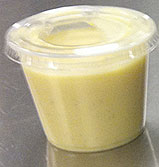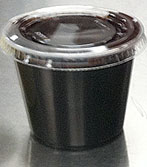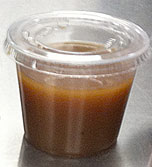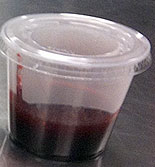
We spent the first part of class talking about TV and Film that cover the current state of nutrition in America. A new show starts tonight called Jamie Olivers Food Revolution. Here’s a blurb on the show from ABC:
The impassioned chef is taking on obesity, heart disease and diabetes in the USA, where our nation’s children are the first generation not expected to live as long as their parents. Now that’s scary!
Jamie is inviting viewers to take a stand and change the way America eats, in our home kitchens, schools and workplaces with the thought-provoking new series, Jamie Oliver’s Food Revolution, which has a special sneak preview Sunday, March 21 10|9c on ABC, followed by a 2-hour premiere on Friday, March 26 8|7c.
This weeks class covered four categories of pastry sauces. Like last week, this class did not create any finished products (except for ice cream, which I ate so fast I forgot to take a picture). Creme Anglaise (vanilla sauce) is considered the mother sauce because it is used as the base in a lot of products (puddings, ice cream, etc). We also made chocolate sauce, caramel sauce, and fruit sauce. All sauces do not store well in sauce bottles and should be stored in an airtight container, the less air in the container the longer the sauce will last. Some sauces are freezable, its best to try a little and see what happens when its defrosted if in doubt. The store-bought sauces are very expensive and full of fillers and stabilizers that alter the taste and nutritional value.
Creme Anglaise (Vanilla Sauce)
 This is known as the “Mother Sauce” because it is the base for so many products. The sauce is made using the tempering method. A portion of a hot dairy mixture is pored into an egg and sugar mixture; and then that egg mixture is returned to the hot mixture.
This is known as the “Mother Sauce” because it is the base for so many products. The sauce is made using the tempering method. A portion of a hot dairy mixture is pored into an egg and sugar mixture; and then that egg mixture is returned to the hot mixture.
There is no cornstarch used in this sauce to thicken it, which creates a nape (a sauce that is just thick enough to cover the back of a spoon). It’s important to stir at a very low heat, directly over the heat source in order to not overcook (lumps) or undercook (to thin). It should be mixed with a whisk, but be careful not to add too much air to the mixture. As the sauce cools it will thicken slightly. It’s important to only cook it until it just covers the back of a spoon. This sauce is a base for ice cream.
This sauce will last three to four days in the refrigerator, tightly covered.
Chocolate Sauce
 You can alter the flavor of any chocolate sauce by using different chocolates. The more expensive the chocolate the better the taste (as a general rule). If you’re using the sauce for children’s deserts or a minimal side you may want to use cheaper chocolate in the recipe. If you have chocolate that has developed a gray cast to it, it’s still good. It’s not mold, but rather the cocoa butter that has surfaced over time. Melting it down will re-incorporate it into the chocolate.
You can alter the flavor of any chocolate sauce by using different chocolates. The more expensive the chocolate the better the taste (as a general rule). If you’re using the sauce for children’s deserts or a minimal side you may want to use cheaper chocolate in the recipe. If you have chocolate that has developed a gray cast to it, it’s still good. It’s not mold, but rather the cocoa butter that has surfaced over time. Melting it down will re-incorporate it into the chocolate.
The key to making a chocolate sauce is to make a paste with the cocoa powder rather than trying to mix it all in at once. The chocolate should be melted over a double boiler and never over direct heat.
The sauce will harden under refrigeration and will need to be warmed up again, using a water bath rather than the microwave which will create sugar crystals. This sauce will keep for months in the refrigerator as long as it’s kept clean. The sugar content helps reserve it.
Caramel Sauce
 There are many different ways to make caramel sauce. We learned the water method in the class. Using a heavy bottomed stainless pot water is applied with a pastry brush to keep the sides clean during the cooking process. This along with lemon juice stops crystallization of the sugars. Aluminum pans have pockets which hold impurities that will make your sauce crystalize and should not be used for this.
There are many different ways to make caramel sauce. We learned the water method in the class. Using a heavy bottomed stainless pot water is applied with a pastry brush to keep the sides clean during the cooking process. This along with lemon juice stops crystallization of the sugars. Aluminum pans have pockets which hold impurities that will make your sauce crystalize and should not be used for this.
When cooking the caramel one is looking for the liquid to turn a golden brown, similar to the color of freshly brewed ice tea. If you use a non-stick or copper pan you will not be able to tell when the cooking is done. If it gets any darker than this it will taste burnt. If the cooking process is stopped before this stage the flavor of the sauce will sugary. It’s important to use a large pot because the sauce boils considerably then the milk and cream are added.
Caramel sauces are quite versatile and can be flavored with everything from alcohol to citrus flavors. Alcohol-based extracts should be added at the end, the heat during the process will cook out their flavors. If using vanilla bean, scrape the seeds into the milk and cream before adding it to the pan. There is no need to steep the milk first for optimal flavor since the hot sugar will make the milk boil.
Fruit Sauces
 When making fruit sauces for a restaurant or bakery, frozen fruit is the best choice. The fruit is much more consistent in taste, sweetness, and ripeness than fresh fruit. Regardless, one must watch the sugar in the sauce and taste the sauce as you’re making it to get to the right amount of sweetness. Canned fruits are not a good choice for sauces. They are usually packed in a syrup and have added sugars, colors and preservatives.
When making fruit sauces for a restaurant or bakery, frozen fruit is the best choice. The fruit is much more consistent in taste, sweetness, and ripeness than fresh fruit. Regardless, one must watch the sugar in the sauce and taste the sauce as you’re making it to get to the right amount of sweetness. Canned fruits are not a good choice for sauces. They are usually packed in a syrup and have added sugars, colors and preservatives.
You can make your own Individually Quick Frozen (IQF) fruit by cleaning and de-stemming fresh fruit and freeze it in a single layer on a baking sheet. The fruit once frozen can then be packaged in bags for future use. Avoid getting to much water on the fruit during the cleaning or you will get watery sauces.
Some fruit sauces are cooked and some are not, almost all are strained for seeds. Some fruit, like kiwi and pineapple, make better raw sauces because their color changes to brown when cooked. Its also important to not blend some fruits in a blender, like a kiwi, its seeds will turn your mixture gray.
Cooked sauces are thickened by reduction and or chemicals (cornstarch). When thickening with cornstarch its best to make a slurry (watery paste) and then add it to the heated sauce. In a restaurant environment, chemical reduction is preferred because it cost less than reduction.